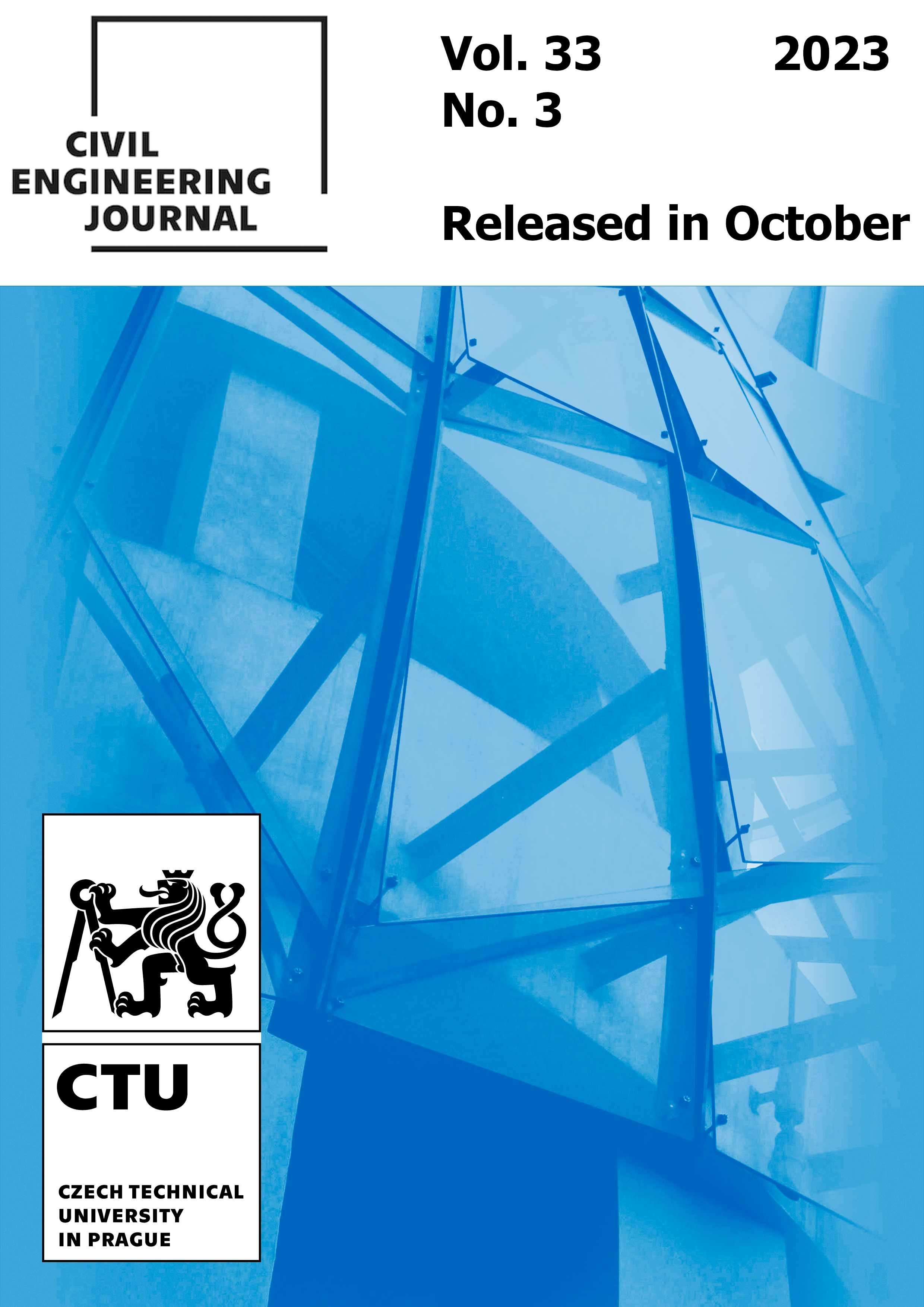RESEARCH ON UNBALANCED WEIGHING EXPERIMENT OF MULTI-POINT BRACED SWIVEL CABLE-STAYED BRIDGE
DOI:
https://doi.org/10.14311/CEJ.2023.03.0029Keywords:
Cable-stayed bridge, Swivel construction, Multi-point braced, Spherical hinge rotation method, Weighing experimentAbstract
To guarantee the safety of the swivel process, the weighing experiment before the swivel is especially important. Based on this, this paper takes a twin-tower, double-cable prestressed concrete swivel cable-stayed bridge as the background and suggests a multi-point braced swivel weighing experiment involving the joint force of the arm-brace and the spherical hinge to solve problems such as a particular obstacle in the relying project's swivelling process. Firstly, the relevant weighing experiment formulas for various circumstances were theoretically derived. The field test results were then used to calculate the jacking force at the limit state during the jacking process, which was then substituted into the relevant formulae, and the relevant parameters of the weighing experiment were calculated. Finally, the counterweight is adjusted based on the weighing results to carry out the structural rotation. The angular velocity was stable during the swivelling process, and the structure was successfully swivelled. The successful practice of a multi-point braced swivel weighing experiment involving the joint force of the arm-brace, and the spherical hinge can provide a reference for the design and construction of similar bridges.
Downloads
References
Zhang L. Y., 2003, Rotating Construction of Bridge : Summary of Rotation Construction of Balanced Rotation System. China Communications Press: Beijing.
Yang H. P. et al., 2017, “Review of China's Rotation Cable-Stayed Bridge Development”, Modern Transportation Technology, 14(06): 34-39.DOI: 10.3969/j.issn.1672-9889.2017.06.010.
Li L. P., 2009, “Plane Swivel Construction Technology of Continuous Box Girder Bridge”, Railway Standard Design, (08): 55-57.DOI: 10.3969/j.issn.1004-2954.2009.08.017.
Ren H et al., 2008, “Construction Control for Gushan Bridge of Shitai Passenger Line”, Journal of Shijiazhuang Railway Institute(Natural Science), 21(04): 52-56.DOI: 10.3969/j.issn.2095-0373.2008.04.012.
Zhang J. F., 2006, “Construction Technology of Level Swing Method of a T-Rigid Frame Bridge”, Journal of Shijiazhuang Railway Institute, (04): 114-117.DOI: 10.3969/j.issn.2095-0373.2006.04.028.
Zhang W. X. et al., 2012, “Analysis of Influencing Factors of Continuous Box-girder Bridge in the Process of Horizontal Rotation”, Journal of Shijiazhuang Railway Institute, 25(04): 30-33.DOI: 10.3969/j.issn.2095-0373.2012.04.007.
Cheng F. et al., 2011, “Development Status and Prospect of Bridge Swivel Construction Technology in China”, Railway Standard Design, (06): 67-71.DOI: 10.3969/j.issn.1004-2954.2011.06.018.
Wang Z. B. et al., 2011, “Monitoring Technology for Rotation Construction of Cable Stayed Bridge in Baoding City Lekai Street”, Railway Engineering, 60(09): 53-56.DOI: 10.3969/j.issn.1003-1995.2020.09.13.
Guo X. G., 2012, “Research on the Mechanical Behavior of Rotation Construction of Cable-Stayed Bridge under Multi-Variable Coupling Effects”, Master thesis of Northeast Forestry University, Heilongjiang, China.
MOT(Ministry of Transport of the People's Republic of China) . 2018. Specifications for Design of Highway Reinforced Concrete and Prestressed Concrete Bridges and Culverts. JTG 3362-2018. Beijing, China: MOT
Yang Y. Q., 2013, “Study on Swivel Weighing Experiment of Xingheng Expressway Overpass Crossing Existing Line”, Railway Engineering, (08): 41-43.DOI: 10.3969/j.issn.1003-1995.2013.08.13.
Wang S. J. and Zhu X., 2011, “Application of CAD and Finite Element Method in the Gravity Center Analysis of Body Rotating Cable-Stayed Bridge”, Advanced Materials Research, (1269): 243-249.DOI: 10.4028/www.scientific.net/AMR.243-249.1549.
Niu Y. Z. et al. 2015, “The Type Research on Super Large Tonnage Hinge of Horizontal Rotating Stayed Bridge”, Journal of Railway Engineering Society, 32(06): 34-39.DOI: 10.3969/j.issn.1006-2106.2015.06.008.
Liu X. M., 2016, “Construction Technique of Synchronized Rotation of Twin T Frames for a Continuous Rigid Frame Bridge”, World Bridges, (01): 25-29.DOI: 10.3969/j.issn.1671-7767.2016.01.006.
Liu J., 2019, “Force analysis and unbalanced torque prediction of spherical hinge in parallel swivel bridge construction”, Master thesis of Shandong University, Shandong, China.
Luo L. J., 2020, “Accurate Calculation Method of Vertical Friction Moment of Spherical Hinge in Bridge Rotation Construction”, Railway Engineering, 60(01): 27-30.DOI: 10.3969/j.issn.1003-1995.2020.01.07.
Luo L. J., 2019, “Unbalanced Weighing Test for Changfeng Avenue Viaduct in Wuhan”, World Bridges, 47(06): 46-50.DOI: 10.3969/j.issn.1671-7767.2019.06.010.
MOT(Ministry of Transport of the People's Republic of China) . 2020. Specifications for Design of Highway Cable-stayed Bridge. JTG/T 3365-01-2020. Beijing, China: MOT
Downloads
Published
Issue
Section
License
Copyright (c) 2023 Stavební obzor - Civil Engineering Journal

This work is licensed under a Creative Commons Attribution-NonCommercial 4.0 International License.
Authors who publish with this journal agree to the following terms:
- Authors retain copyright and grant the journal right of first publication with the work simultaneously licensed under a Creative Commons Attribution License that allows others to share the work with an acknowledgement of the work's authorship and initial publication in this journal.
- Authors are able to enter into separate, additional contractual arrangements for the non-exclusive distribution of the journal's published version of the work (e.g., post it to an institutional repository or publish it in a book), with an acknowledgement of its initial publication in this journal.
- Authors are permitted and encouraged to post their work online (e.g., in institutional repositories or on their website) prior to and during the submission process, as it can lead to productive exchanges, as well as earlier and greater citation of published work (See The Effect of Open Access).
How to Cite
Accepted 2023-10-02
Published 2023-10-30










